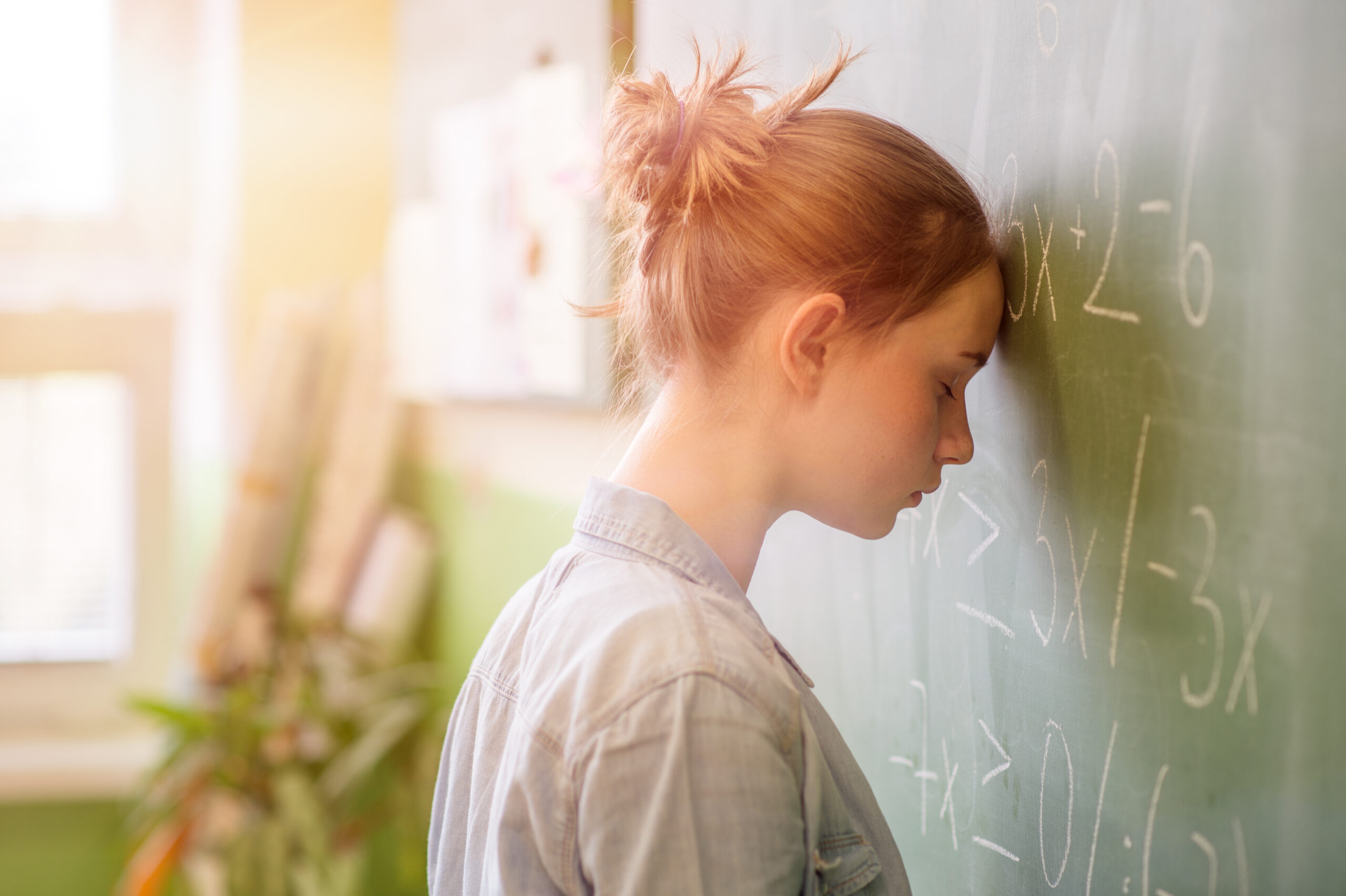
Hidden Signs of Anxiety in Teens
July 1, 2024
Teen anxiety is more than just a phase of growing up—it’s a serious mental health concern affecting many adolescents worldwide. Despite its prevalence, it often goes unnoticed, as the signs can be subtle and easily overlooked.
This article aims to shine a light on these hidden signs, helping parents, educators, and caregivers recognize and address teen anxiety effectively. We’ll explore the less obvious symptoms of anxiety and provide valuable coping strategies and support mechanisms.
Understanding teen anxiety is the first step towards helping our teens navigate this challenging phase.
Learn more about our teen anxiety treatment programs or call us now at 800-275-1707.

Understanding Teen Anxiety
Teen anxiety is more than just typical teenage angst. It’s a mental health disorder characterized by excessive worry and fear. These feelings can interfere with a teen’s daily activities. They can affect school performance, social interactions, and overall well-being. Here are some key points to understand about teen anxiety: It’s different from adult anxiety. Teens express their anxiety in ways that adults may not recognize. It’s common among adolescents. Many teens experience some form of anxiety. It can have serious consequences if left untreated. It can lead to academic difficulties, social isolation, and even substance abuse.What is Teen Anxiety?
Teen anxiety is a type of anxiety disorder. It’s specific to adolescents aged 13 to 19. It’s characterized by persistent feelings of worry and fear. These feelings are often disproportionate to the situation at hand. Anxiety can manifest in various ways in teens. It can lead to physical symptoms, changes in behavior, and difficulties in school.Prevalence and Impact
Anxiety disorders are among the most common mental health issues in teens. According to studies, about 25% of teens experience anxiety at some point. The impact of teen anxiety is far-reaching. It affects not only the teens themselves but also their families and communities. Untreated anxiety can lead to poor academic performance, social withdrawal, and other mental health issues. It’s crucial to recognize and address teen anxiety early to prevent these potential consequences.Common vs. Hidden Symptoms
Anxiety in teens can manifest in various ways. Some symptoms are easily recognizable, while others are more subtle. Recognizable symptoms include excessive worry, restlessness, and difficulty concentrating. These are the symptoms most people associate with anxiety. However, there are also hidden signs of anxiety. These are symptoms that are often overlooked or mistaken for typical teen behavior. Here are some common and hidden symptoms of teen anxiety: Common symptoms:- Excessive worry
- Restlessness
- Difficulty concentrating
- Avoidance behavior
- Procrastination
- Changes in sleeping patterns
Uncovering the Hidden Signs
Hidden signs of anxiety are those that are often overlooked. These include avoidance behavior, procrastination, and changes in sleeping patterns. Avoidance behavior is a common hidden sign. Teens with anxiety may avoid situations or activities that make them anxious. Procrastination is another hidden sign. Teens with anxiety may put off tasks because they feel overwhelmed. Changes in sleeping patterns can also indicate anxiety. Teens with anxiety may have trouble falling asleep or staying asleep. They may also sleep more than usual to escape from their worries.Physical Indicators of Teen Anxiety
Anxiety doesn’t just affect the mind. It can also cause physical symptoms and health problems. These are often overlooked when assessing teen anxiety. Physical symptoms can include stomachaches, headaches, and changes in eating habits. These symptoms can be mistaken for other health issues, it’s important to note that these symptoms can manifest from other illnesses but can be associated with anxiety.Somatic Symptoms Often Overlooked
Physical symptoms of anxiety are often overlooked. This is because they can be mistaken for other health issues.- Stomachaches are a common physical symptom of anxiety. Teens with anxiety may complain of stomachaches, especially in stressful situations.
- Headaches are another common symptom. Teens with anxiety may experience frequent headaches.
- Changes in eating habits can also indicate anxiety. Teens with anxiety may eat more or less than usual. They may also have specific food cravings or aversions.
Behavioral Changes and Academic Performance
Anxiety can lead to changes in a teen’s behavior and academic performance. These changes can be subtle, but they are important to notice. Here are some signs to look out for:- Changes in social interactions – lack of social activity, staying away from their friends and family.
- Avoidance behavior – not wanting to have conversations, eat at the dinner table, avoiding leaving the house, and refusing to go to school.
- Procrastination – putting off important tasks such as cleaning the house, putting off school projects, etc.

Shifts in Behavior and Interests
Changes in a teen’s behavior can be a sign of anxiety. For example, a teen might start avoiding social situations. Avoidance behavior is a common sign of anxiety. This can include avoiding school, social events, or even family gatherings. Procrastination can also be a sign of anxiety. Teens with anxiety might put off tasks because they feel overwhelmed.Anxiety’s Effect on Schoolwork
Anxiety can also affect a teen’s academic performance. This can manifest as difficulty concentrating or remembering information. Teens that feel anxious may struggle with schoolwork. They might have trouble focusing or completing assignments. If a teen’s grades start to drop, it could be a sign of anxiety. It’s important to consider mental health as a possible factor.The Role of Social Dynamics
Social dynamics play a significant role in teen anxiety. This includes the impact of social media and peer relationships. Here are some key points to consider:- Social media’s impact on teen stress
- The role of peer relationships in teen anxiety
- Understanding these dynamics can help identify signs of anxiety in teens.
Social Media and Peer Relationships
Social media can contribute to anxious feelings in teens. Teens often compare themselves to others, leading to feelings of inadequacy. Peer relationships also play a role in teen anxiety. Teens can feel pressure to fit in, leading to stress and anxiety. Bullying, both online and offline, can also contribute to anxiety. It’s important to monitor for signs of bullying. Understanding the role of social dynamics in teen anxiety can help in identifying and addressing the issue. It’s crucial to foster open communication about these topics.Coping Strategies and Support
Coping strategies and support are crucial in managing and treating anxiety. This includes both home-based support and professional help. Here are some key points to consider:- Encouraging communication at home
- The role of professional help and therapeutic options
- Understanding these strategies can help teens manage their anxiety effectively.
Encouraging Communication and Support at Home
Open communication at home is vital. Parents and guardians should encourage teens to express their feelings. Creating a supportive home environment can help teens cope with their fears and worries. This includes maintaining a routine and structure. It’s also important to monitor for changes in behavior. Regular check-ins can help identify signs of anxiety early.Professional Help and Therapeutic Options
Professional help is often necessary when anxiety interferes with daily life. This can include counseling or cognitive-behavioral therapy (CBT). Medication may also be an option. However, the potential risks and benefits should be discussed with a healthcare provider. Alternative therapies, such as art therapy or music therapy, can also be beneficial. These therapies can provide a creative outlet for teens to express their feelings.Encouragement for Proactive Steps
Recognizing and addressing teen anxiety is crucial. It’s important to understand that anxiety is not just a phase that teens will outgrow. Early intervention can prevent the escalation of anxiety symptoms. It’s essential to foster a non-judgmental atmosphere when discussing mental health with teens. If your teen is in need of additional support, our team at Hillcrest Adolescent Treatment Center is available to build a personalized treatment plan that can guide your teen in the right direction with their mental health. In conclusion, teen anxiety is a serious issue that requires attention. By understanding the hidden signs and providing the right support, we can help teens navigate this challenging phase of their lives.Take Our Anxiety Test for Teens
This thoughtfully designed assessment guides you through common behavioral patterns and emotional responses that might indicate an anxiety disorder, distinguishing between typical teenage stress and more persistent anxiety symptoms.
Posted in Teen Mental Health
